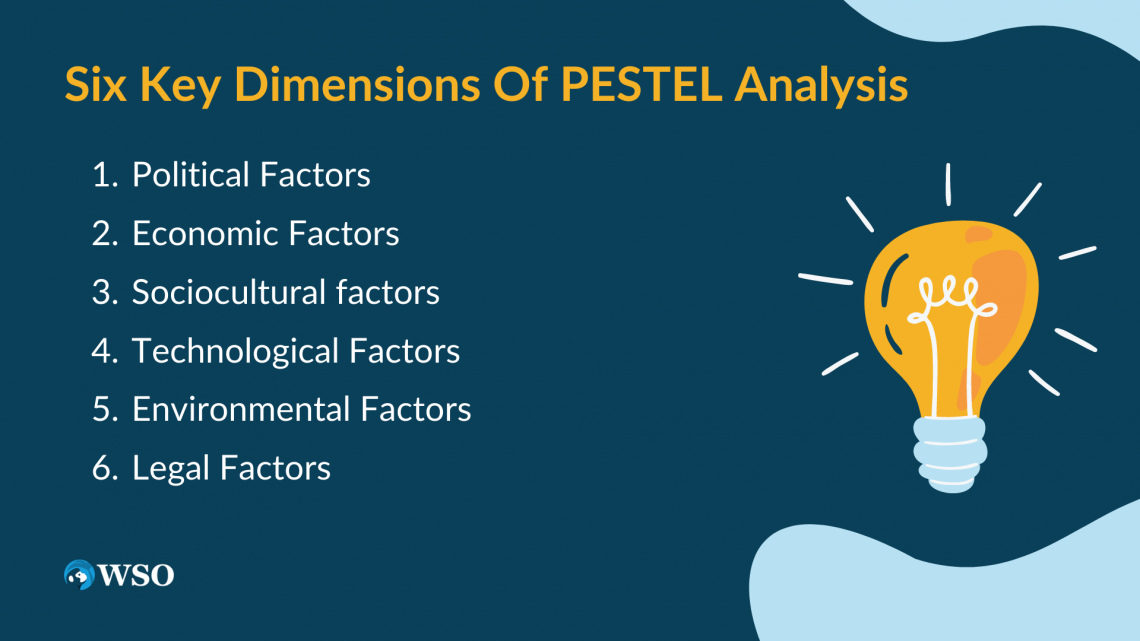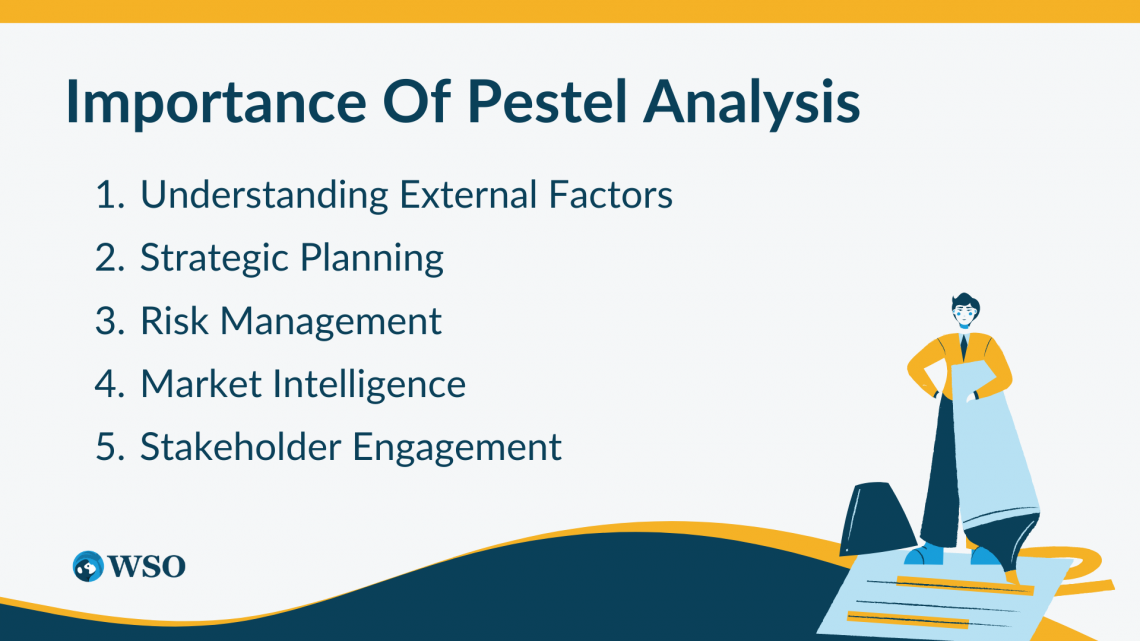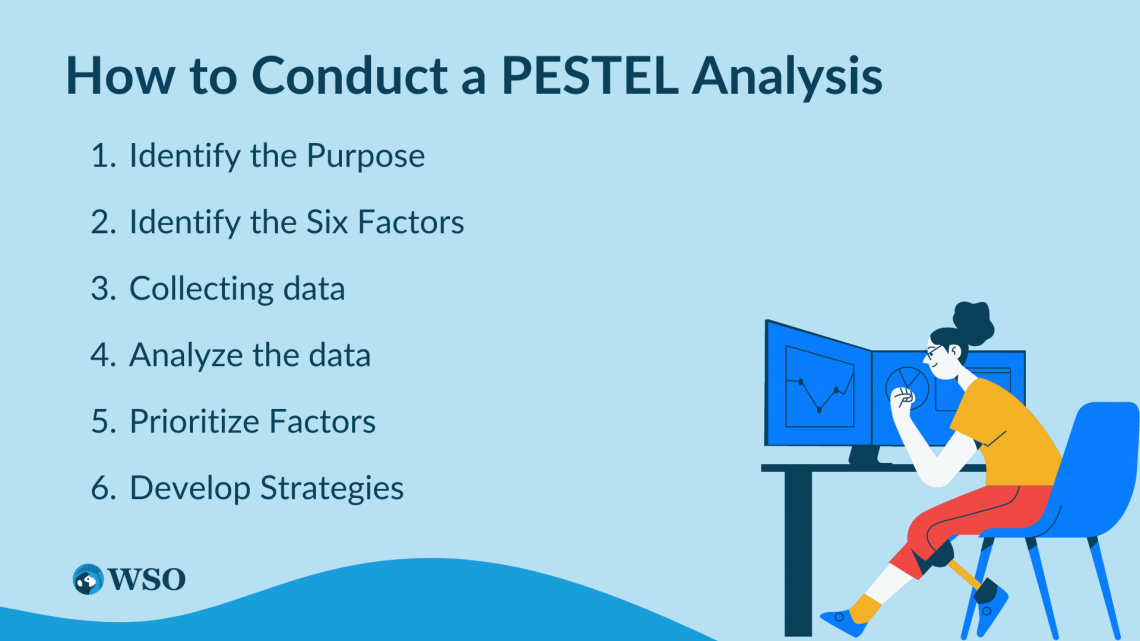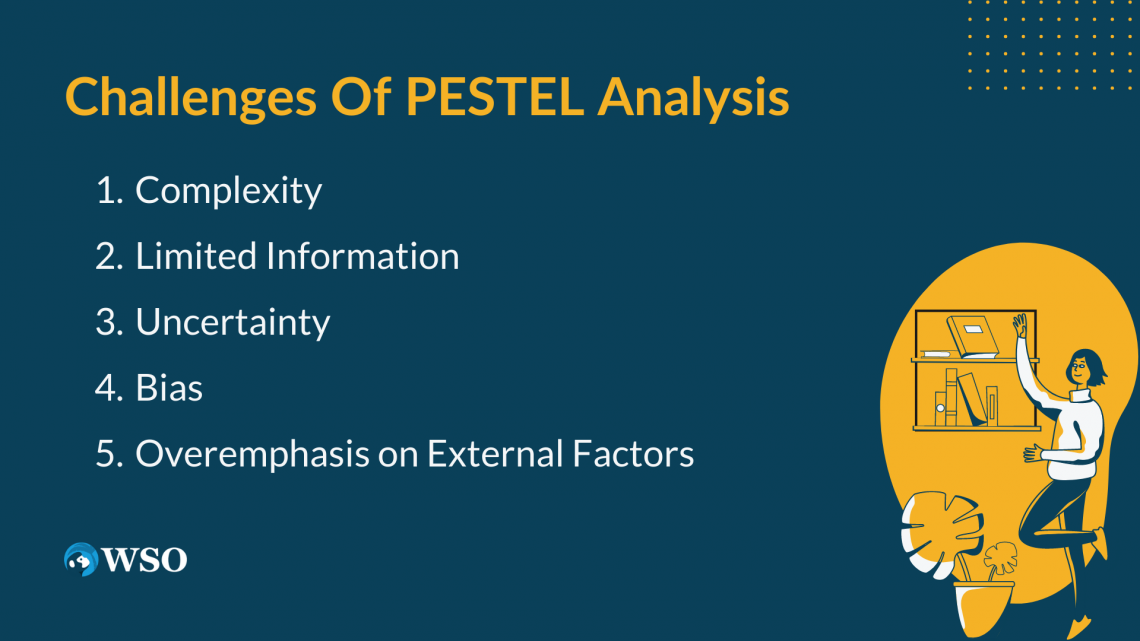PESTEL Analysis
It is a tool used to analyze the external macro-environmental factors that can impact an organization's operations and long-term sustainability.
What is a PESTEL Analysis?
Pestel analysis is a device used to investigate the external macro-environmental factors that impact an organization. Those elements include political, economic, sociocultural, technological, environmental, and legal.

Comprehending their market, competition, and position within it is vital for corporations, governments, and other institutions.
By undertaking this analysis, firms examine the external factors that would affect their long-term sustainability, operations, and business approach.
It facilitates the discovery of possibilities and threats, informs decision-making, and aids in developing proactive strategies to navigate the dynamic enterprise landscape.
It can be used in market research, expanding into new markets, or assessing the profitability of business ventures. A complete evaluation allows agencies to become aware of possibilities, assume risks, and adapt their techniques to align with the external environment.
Key Takeaways
- PESTEL analysis is a tool used to analyze the external macro-environmental factors that can impact an organization's operations and long-term sustainability.
- The six dimensions of PESTEL analysis are Political, Economic, Social, Technological, Environmental, and Legal.
- PESTEL analysis helps organizations identify opportunities, threats, and potential risks, enabling them to adapt and navigate the dynamic business landscape.
Understanding PESTEL Analysis
It examines six key dimensions: Political, Economic, Social, Technological, Legal, and Environmental.

Here's a breakdown of each dimension:
Political Factors
Political factors refer to government policies and regulations that impact the business environment. This includes taxes, trade policies, labor laws, tariffs, and government stability.
For instance, modifications to tax legislation can considerably affect a company's profitability.
Additionally, modifications to legislation may impact a company's capacity to compete in a particular market. Political instability in a country can also significantly impact a company’s ability to do business.
Example
The 2021 coup in Myanmar devastated the country’s economy, causing foreign businesses to reconsider their investments.
Economic Factors
Economic factors refer to the broader economic conditions that impact a business. This covers economic expansion, exchange rates, and inflation rates.
Inflation fees have an impact on the cost of goods and services, which might also affect how profitable an enterprise is; interest fees have an impact on product and service expenses, which may affect an organization's profitability.
Note
The borrowing cost is determined by interest rates, which influence an organization's ability to grow and invest.
Exchange rates impact the competitiveness of a company’s products and services in global markets. Economic growth is an essential factor for businesses as it determines the purchasing power of consumers.
Sociocultural factors
Sociocultural factors are the cultural, social, and demographic factors that impact a business. This includes changes in consumer behavior, lifestyle changes, and cultural attitudes.
For instance, the rise of health-conscious consumers has increased the natural and organic goods market.
Note
Shifting demographic patterns, such as an aging population, might affect a business's goods and offerings.
Technological Factors
Technological factors refer to the advancements in technology that impact a business. This includes changes in automation, artificial intelligence, and digitalization.
For instance, automation has facilitated the automation of numerous manufacturing procedures, increasing productivity and efficiency. Chatbots and other customer support solutions that enhance the client experience have been made possible by artificial intelligence.
Note
Customers now purchase differently, thanks to the rise of e-commerce brought on by digitalization.
Environmental Factors
Environmental factors refer to the impact of the environment on a business. This covers issues including natural catastrophes, climate change, and other environmental worries. For instance, climate change has led to the development of sustainable and environmentally friendly products.
Natural disasters can impact a company’s ability to operate in a specific market. Environmental issues may also negatively affect a business's reputation, costing it clients and money.
Legal Factors
Legal factors refer to the laws and regulations that impact a business. This covers consumer protection legislation, intellectual property rules, and labor laws.
For instance, changes in labor laws can impact how a company hires and manages its employees. Intellectual property laws protect a company’s intellectual property, such as patents and trademarks.
Consumer Protection laws regulate the way that companies interact with consumers and protect consumer rights.
Importance of Pestel Analysis
A PESTEL analysis can help organizations to understand the opportunities and threats in their industry and make informed decisions about their operations.

The following is the importance of doing a PESTEL Analysis:
Understanding External Factors
One of the primary benefits is that it helps organizations to understand external factors that can affect their operations. By identifying these elements, organizations can proactively address potential threats and capitalize on opportunities.
For example, an organization may identify a new government regulation that could impact its operations.
Likewise, an organization may identify a new technology that could disrupt its industry. By understanding this technology, the organization can develop a strategy to adopt it or create a competing technology to maintain its market position.
Note
Without PESTEL Analysis organizations may be blindsided by these external factors and struggle to adapt to changing conditions.
Strategic Planning
It is an important tool for strategic planning. Organizations can develop strategies that exploit opportunities and mitigate potential threats by understanding external factors.
For example, an organization may identify a new market that is opening up due to changes in government policies. The organization can increase its revenue and profitability by developing a strategy to enter this market.
Correspondingly, an organization may identify a new technology to improve its operations. The organization can improve efficiency and reduce costs by developing a strategy to adopt this technology.
Note
Strategic Planning can help organizations identify these strategic opportunities and develop a plan to take advantage of them.
Risk Management
By identifying potential threats, organizations can take proactive measures to mitigate them.
For example, an organization may identify a new competitor that is entering its market. The organization can develop a competitive strategy by understanding the competitor's strengths and weaknesses.
Comparably, an organization may identify a potential environmental risk, such as a natural disaster. By analyzing and understanding the potential impact of this risk, the organization can develop a plan to protect its employees and assets.
Note
It can help organizations identify potential risks and develop a mitigation plan.
Market Intelligence
Organizations can gain insights into their industry and competitors by understanding external factors.
For example, an organization may identify a new trend in customer preferences. By understanding this trend, the organization can develop products or services that meet customer needs.
Similarly, an organization may identify a new competitor that is entering its market. The organization can develop a competitive strategy by understanding the competitor's strengths and weaknesses.
Note
Market Intelligence can help organizations to gather market intelligence and make informed decisions about their operations.
Stakeholder Engagement
Through analyzing external factors, organizations can identify the interests and concerns of stakeholders, such as customers, employees, and regulators.
For example, an organization may identify a new government regulation that concerns its customers. The organization can maintain customer loyalty and avoid potential reputational damage by engaging with these customers and addressing their concerns.
Uniformly, an organization may identify a new environmental risk that concerns its employees. The organization can maintain a positive corporate culture and avoid potential labor disputes by engaging with these employees and addressing their concerns.
Note
Stakeholder Engagement can help organizations to engage with stakeholders and build positive relationships with them.
How to Conduct a PESTEL Analysis
Conducting a PESTEL analysis involves systematically evaluating the external factors that can impact an organization.

Here are the steps:
- Identify the Purpose: The first process in conducting this analysis is to identify the purpose of the analysis. What are the organization's goals and objectives? What information is needed to make informed decisions? This information will help guide the analysis and evaluate the right factors.
- Identify the Six Factors: The second step is to identify the six factors of PESTEL analysis: Political, Economic, Social, Technological, Environmental, and Legal. Each of these elements should be assessed independently because they each have different potential effects on an organization.
- Collecting data: The following stage is to compile data on each of the six factors. This can be accomplished through research, polls, and stakeholder interviews. To make the analysis more accurate, more information must be collected.
- Analyze the data: After the data has been gathered, analysis is required. Finding patterns, trends, and prospective effects on the organization is necessary for this. Both sound and negative effects, as well as any prospective possibilities or risks, should be considered.
- Prioritize Factors: Prioritizing the elements based on their amount of impact on the organization is the next stage after information analysis. The organization will be able to focus on what matters most and develop strategies to deal with it by doing this.
- Develop Strategies: The final step is to develop strategies to address the external factors identified in the analysis. Those strategies ought to be tailored to the organization's dreams and goals and should consider the level of effect of each factor.
Note
It is vital to develop each short-time period and long-time period strategy to ensure that the enterprise can adapt to adjustments in the outside surroundings.
By following these steps, organizations can conduct a thorough and effective PESTEL analysis that will help them make informed decisions and develop strategies to address external factors that can impact their operations.
Challenges of PESTEL analysis
While conducting this, organizations must keep in mind the challenges associated with the process. This analysis faces many challenges.

The following are the main challenges:
1. Complexity
One of the main challenges is the complexity of the external factors that it covers. All of the six factors - Political, Economic, Social, Technological, Environmental, and Legal - could have many sub-factors which may impact an organization.
The complexity of all these can make it difficult for organizations to identify and analyze all of the relevant factors.
2. Limited Information
Another challenge is the availability and reliability of information. Organizations may not have access to all the information they need to analyze external factors thoroughly.
In addition, the available information may be incomplete or unreliable. This can lead to inaccurate conclusions and ineffective strategies.
3. Uncertainty
External factors constantly change, making it difficult for organizations to understand how these modifications will impact their operations.
This uncertainty can make it difficult for organizations to develop effective strategies based on PESTEL analysis.
Example
A change in government policy may have unforeseen consequences that can't be predicted in advance.
4. Bias
Another challenge is the potential for bias. Organizations may have preconceived notions about certain external factors that can influence their analysis.
For example, an enterprise could have a bias against environmental policies that may cause them to underestimate the impact of environmental factors on their operations. This bias can lead to inaccurate conclusions and ineffective strategies.
5. Overemphasis on External Factors
Subsequently, it may cause an overemphasis on outside factors at the expense of internal factors. While external factors are crucial, organizations also need to consider their internal strengths and weaknesses.
Focusing solely on external factors can lead to a neglect of internal factors that can significantly impact an organization's operations.
Conclusion
In conclusion, It is a valuable tool for organizations to evaluate the external environment and make informed decisions about their operations.
Businesses can better recognize the possibilities and problems they confront by studying the political, economic, social, technological, environmental, and legal issues which could impact their enterprise.
While performing it, organizations must consider the procedure's associated challenges. These challenges include the complexity of external factors, limited information, uncertainty, bias, and overemphasis on external elements.
It is also critical to recognize that it should not be performed in isolation. Organizations must consider their internal strengths and weaknesses and evaluate their competitors and industry trends to make informed decisions and expand effective techniques.
It may assist organizations in identifying potential opportunities and threats and making decisions about their operations. By analyzing this political factor, the company can develop strategies to mitigate the impact of the policy change.
Similarly, an enterprise may conduct and identify technological improvements that could enhance its operations. By analyzing this technological aspect, the company can invest in new technology and gain a competitive advantage in the market.
It is a valuable tool for enterprises to examine their external environment and make informed choices about their operations.
Organizations can position themselves for long-term success in a continuously changing market by tackling the process's limitations and adopting the findings into their strategic plans.
PESTEL Analysis FAQs

Political factors such as government policies, regulations, and stability can significantly impact a business.
Changes in the political climate can affect taxes, trade policies, and the general business environment.
Economic factors such as inflation, exchange rates, interest rates, and monetary growth can significantly affect a business. Changes in these factors can affect the demand for products or services, cost of production, and revenue.
Social factors such as cultural values, demographics, lifestyle trends, and consumer behavior can significantly impact a business.
Changes in social factors can affect the demand for products or services, marketing strategies, and the overall business environment.
Technological factors such as innovation, automation, and digitalization can significantly impact a business.
Technology changes can affect how products or services are produced and delivered, the marketing and sales channels, and the overall enterprise operations.
Legal factors such as regulations, laws, and litigation can significantly impact a business. Modifications in legal factors can affect the way products or services are produced, marketed, and sold and can also affect the overall enterprise environment.
Environmental factors, including climate change, sustainability, and natural resources, can significantly impact a business.
Environmental factors can affect how products or services are produced and delivered, the marketing and sales channels, and the overall enterprise operations.




or Want to Sign up with your social account?